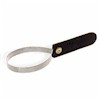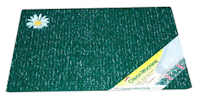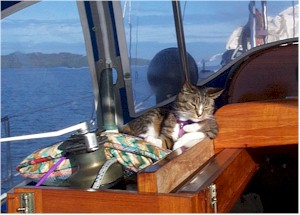
Bunks are cozier with cats
 |
|
Bunks are cozier with cats |
Over the past couple of years of maintaining this cruising website, we've gotten a lot of emails from people asking questions about how to live aboard and cruise with cats. Our cats may be a bit strange sometimes, so maybe the issues we deal with are particular only to them, but hopefully our tips on how we live with them may help you live and travel with your cats on your boat.
First of all, we absolutely love having our cats on board, and highly recommend people cruise with pets (cats or dogs). Precious and Xena most love when after a day of sailing, the anchor is set and all is quiet, to run around decks excitedly checking out our new view. Their innocence and excitement adds a special dimension to our cruising experience. Time after time, they remind us of what really matters in life: that you feel safe, have food in your bowl, and have a warm place to sleep with someone who loves you. Our cats are part of our family and we couldn't imagine not having them along now.
At the same time, cats on a boat can be a LOT of work which mostly consists of keeping them, their litter and their hair contained.
 |
|
Shedding Tool |
Cats simply produce an amazing amount of hair and you will find it everywhere. It is essential that you check your bilge pumps regularly, because you will find they get hair balls a lot (the bilge pumps AND the cats actually). Regular brushing of both our cats helps keep the hair in check. We like to use a regular slicker brush and during summer what is called a "shedding tool," which looks sort of like a metal torture device, but they really love it and it removes dead hair wonderfully.
You will also find hair stuck all over your cushions, or any other cloth surface including carpets. To remove it: buy a pair of yellow rubber dishwashing gloves, put one on each hand and start rubbing the cushions. Really. The cat hair balls right up and you can scoop or vacuum it away. This little trick has saved our sanity more than any other.
 |
|
Potty Mat |
We do not use it on board. The cats would only scatter it everywhere along with their hair and I could not imagine the mess. Instead, the cats share a large covered litter box lined with a piece of Astroturf mat (the kind you can buy at Kmart with the plastic daisy on the corner). We cut each mat in half to make two liners. Each liner is good for about three months before the smell seems to permeate and begins to drive us out of the boat. We are going to try rinsing the mat in vinegar to see if this prolongs the life of the mat, which will help when traveling far away from Kmarts.
To get your cats used to using a turf-mat, sprinkle a bit of their regular litter on top of it for a week or so. They'll get the idea quickly.
It is best to clean the mat out everyday, since the cats can accidentally track messes around if the box is too full. If at sea, we simply dump all the contents overboard and rinse the mat and litter box out with seawater; in the marina or inland we scoop the solid pieces into a container or baggie, dispose of properly, and rinse the mat out in the water.
 |
|
A sailing cat has a hard life |
We never lets the cats roam the dock by themselves, for a number of reasons:
1. Your dock neighbors will not be your friends after they find your
cats exploring their boat.
2. Your cats can get trapped in a closed boat and get real hungry.
3. Your cats will not stay on your dock and get lost on other docks.
4. A marina parking lot is no place for a cat.
5. Once you let a cat roam, all previous training successes are lost.
So, keep your cat on your boat at all times. Tell them to never step off the boat, and if they do they'll be in big trouble.
If your cats are anything like ours, they will ignore you. So, you may have to tie them up. Both our cats wear tiny cat harnesses and each has a 6' long leash that will allow them to roam the cockpit, but keep them on the boat. This comes in handy both at the dock, and when sailing when tethers are required for everyone.
As mentioned above, our cats love being at anchor the best because this means they can run freely around the deck. They do not like to swim, but they have tried to swim ashore once or twice. We have always been able to rescue them with the boat hook, or grabbing their harnesses, or by them climbing up a fender or into the dinghy. A good solution is to keep a piece of carpet tied over the side, but we prefer to simply keep an eye on them always when they are outside darting around deck.
So far, we have cruised with the cats in Washington, Canada, and Alaska. This year we will be heading south to foreign ports. We'll keep you updated on how we do cruising with kitties in warm foreign waters, and possibly some airplane or train rides. We know Xena is counting down the days when she can lay outside in the warm sunshine, and frankly so are we.
Back to the Projects & Ideas Index